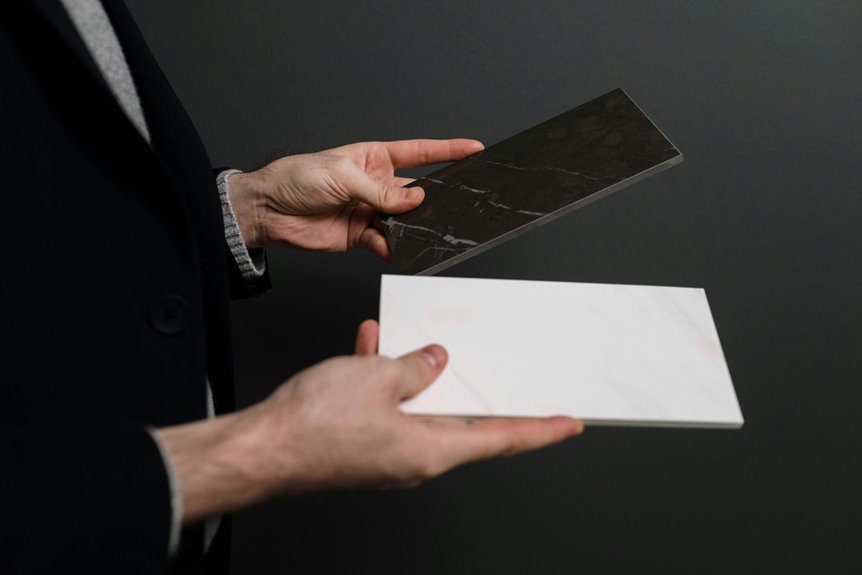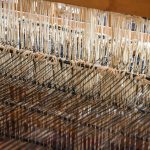If you need tough, reliable fabric, Kevlar usually outperforms ballistic nylon due to its exceptional molecular strength and impact resistance. Kevlar is lighter, stronger, and better at stopping high-velocity threats, though it’s pricier and less flexible. Ballistic nylon offers good abrasion resistance and flexibility at a lower cost, making it great for everyday gear. Understanding these trade-offs helps you pick the best option for your needs—there’s more to explore about how each fabric performs in specific situations.
Table of Contents
Key Takeaways
- Kevlar offers superior tensile strength and impact resistance compared to ballistic nylon, making it better for high-stress protective applications.
- Ballistic nylon provides excellent abrasion resistance and flexibility, suited for durable everyday gear like backpacks and luggage.
- Kevlar is lighter and more flexible than ballistic nylon, enhancing comfort and mobility in protective clothing.
- Ballistic nylon resists moisture and mildew better, while Kevlar requires careful storage to prevent UV and moisture damage.
- Kevlar’s higher cost and complex production limit its use to specialized applications, whereas ballistic nylon is more affordable and widely available.
Composition and Manufacturing Process
Although both ballistic nylon and Kevlar are engineered for durability, their composition and manufacturing processes differ considerably.
You’ll find ballistic nylon is a synthetic fabric made from nylon fibers woven tightly in a basketweave pattern. This weaving method boosts its abrasion resistance and toughness.
Kevlar, on the other hand, is an aramid fiber produced through a complex chemical process involving poly-paraphenylene terephthalamide. It’s spun into fibers that you can weave into fabric or press into sheets.
While ballistic nylon relies mainly on physical weaving for strength, Kevlar’s strength comes from its molecular structure and chemical bonds.
Understanding these differences helps you appreciate why each material performs uniquely in various applications, even before considering their strength or durability.
Strength and Durability Comparison
When comparing strength and durability, ballistic nylon and Kevlar offer distinct advantages that suit different needs.
You’ll find ballistic nylon is incredibly tough and can withstand a lot of wear over time without tearing, making it ideal for gear that faces rough handling.
Kevlar, on the other hand, boasts exceptional tensile strength, meaning it can handle much higher stress before breaking. This makes Kevlar perfect when you need maximum durability against extreme forces.
However, Kevlar is more rigid and less flexible than ballistic nylon, which might affect comfort in some applications.
Kevlar’s rigidity can reduce comfort compared to the more flexible ballistic nylon in certain uses.
Ultimately, if you want a fabric that balances toughness and flexibility, ballistic nylon is your go-to.
But if your priority is unmatched strength and long-lasting durability under intense stress, Kevlar stands out as the superior choice.
Resistance to Abrasion and Impact
When you’re choosing between ballistic nylon and Kevlar, understanding how each handles abrasion and impact is key.
You’ll want to know which fabric absorbs shocks better and holds up under continuous stress.
Let’s compare their resistance to wear and how they protect against sudden impacts.
Abrasion Resistance Comparison
Since you rely on durable materials to protect against wear and tear, understanding how ballistic nylon and Kevlar stand up to abrasion and impact is crucial.
Ballistic nylon offers excellent abrasion resistance thanks to its dense weave and tough synthetic fibers, making it ideal for gear exposed to rough surfaces. You’ll find it resists scratches and scuffs well, maintaining its integrity over time.
Kevlar, on the other hand, excels with even greater abrasion resistance due to its aramid fiber structure, which is engineered to withstand intense friction and repeated rubbing.
If your priority is maximum abrasion resistance for long-term durability in harsh conditions, Kevlar outperforms ballistic nylon.
However, ballistic nylon still provides solid protection and is often more affordable, so your choice depends on your specific abrasion resistance needs.
Impact Absorption Capabilities
Beyond abrasion resistance, impact absorption plays a key role in how well ballistic nylon and Kevlar protect you.
When you face sudden forces, Kevlar’s tightly woven fibers distribute impact energy more efficiently, reducing blunt trauma. This makes Kevlar ideal for bulletproof vests and helmets where stopping high-velocity projectiles matters.
Ballistic nylon, while tough, doesn’t absorb impacts as effectively; it offers decent resistance against cuts and scrapes but isn’t designed to dissipate intense energy spikes.
So, if your priority is minimizing injury from high-impact hits, Kevlar has the clear advantage.
However, ballistic nylon still provides reliable protection in scenarios with lower impact forces.
You’ll want to choose based on the level of impact risk you expect to encounter, balancing flexibility with absorption needs.
Durability Under Stress
Although both ballistic nylon and Kevlar excel in protective qualities, their durability under stress varies considerably. When you rely on materials that can withstand abrasion and impact, choosing the right fabric is essential. Here’s how they compare:
- Ballistic Nylon: Known for its tough weave, it resists tears and abrasions well but may degrade under extreme impact over time.
- Kevlar: Offers superior impact resistance and maintains structural integrity even after multiple strikes, making it ideal for high-stress environments.
- Longevity: Kevlar generally lasts longer under heavy use, while ballistic nylon performs better in everyday wear and tear situations.
When durability under stress is your priority, Kevlar often outperforms ballistic nylon, especially in scenarios demanding high-impact resistance.
Weight and Flexibility Considerations
When choosing between ballistic nylon and Kevlar, you’ll find that weight and flexibility play crucial roles in their performance.
Ballistic nylon tends to be heavier and less flexible, which can make it feel bulkier when you wear or carry it. This added weight might slow you down or cause discomfort during extended use.
Kevlar, on the other hand, is remarkably lightweight and offers greater flexibility, allowing you to move more freely without sacrificing protection. Its thin, woven fibers conform better to your body, making it ideal for applications where agility matters.
Cost and Availability Analysis
When choosing between ballistic nylon and Kevlar, you’ll want to compare their prices closely.
You’ll also need to evaluate how easy it’s to find each fabric on the market.
Plus, supply chain factors can impact both cost and availability, so keep those in mind too.
Price Comparison
Since both ballistic nylon and Kevlar serve specialized purposes, you might expect their prices to reflect their unique properties and manufacturing processes.
When comparing costs, keep these key points in mind:
- Material Cost: Kevlar is generally more expensive due to its complex production and superior protective qualities.
- Durability vs. Price: While Kevlar costs more upfront, its exceptional strength and heat resistance can justify the investment for high-risk applications. Ballistic nylon offers decent durability at a lower price.
- Bulk Purchase: If you buy in large quantities, ballistic nylon’s cost advantage becomes more noticeable, making it ideal for broader uses like luggage or backpacks.
Understanding these factors helps you decide which fabric fits your budget and performance needs best.
Market Accessibility
Although both ballistic nylon and Kevlar target specialized markets, you’ll find differences in how easily you can access each fabric based on cost and availability.
Ballistic nylon is generally more accessible since manufacturers produce it in larger quantities for a variety of uses like luggage, backpacks, and outdoor gear. You can source ballistic nylon from many suppliers at competitive prices, making it easier to obtain for smaller projects or bulk orders.
Kevlar, on the other hand, is more specialized and typically reserved for high-performance applications such as body armor and aerospace.
Because of its complex production and licensing restrictions, you might face higher costs and limited availability. If you need Kevlar, you’ll often work directly with authorized distributors, which can slow down procurement compared to ballistic nylon’s broader market presence.
Supply Chain Factors
Because supply chain factors heavily influence your project’s timeline and budget, understanding the cost and availability differences between ballistic nylon and Kevlar is essential.
Ballistic nylon generally costs less and is more readily available due to established manufacturing processes and widespread use. Kevlar, being a specialized aramid fiber, tends to be pricier and may face supply constraints, especially during high demand periods.
Consider these supply chain factors:
- Cost: Ballistic nylon is budget-friendly; Kevlar commands a premium price.
- Lead Time: Ballistic nylon has shorter lead times; Kevlar orders might take longer.
- Supplier Diversity: More suppliers offer ballistic nylon, reducing risk; Kevlar sourcing is limited.
Knowing these factors helps you plan effectively and choose the material that fits your project’s scope and timeline.
Common Applications and Use Cases
Both ballistic nylon and Kevlar fabric serve distinct purposes that cater to different needs in protection and durability.
When you need tough, abrasion-resistant gear like backpacks, luggage, or motorcycle jackets, ballistic nylon is your go-to. It’s great for everyday items that must withstand rough handling without tearing.
On the other hand, if you require high-level protection against impacts or penetration, Kevlar’s unbeatable strength is ideal. You’d find Kevlar in bulletproof vests, helmets, and cut-resistant gloves, where safety is critical.
Kevlar provides unmatched protection against impacts and penetration, essential for bulletproof vests, helmets, and cut-resistant gloves.
You might also see Kevlar used in aerospace and automotive industries for lightweight, protective components.
Choosing between them depends on your application: ballistic nylon excels in durable, flexible gear, while Kevlar is preferred for life-saving, high-performance protective equipment.
Environmental and Maintenance Factors
When you consider environmental and maintenance factors, ballistic nylon and Kevlar require different care to keep their performance intact.
You’ll find ballistic nylon is more resistant to moisture and mildew, making it easier to clean and maintain in wet conditions.
Kevlar, on the other hand, is sensitive to UV light and moisture, which can degrade its fibers over time if not properly protected.
Here are key points to remember:
- Ballistic nylon handles water exposure well and can be cleaned with mild soap and water.
- Kevlar needs UV protection and should be stored away from prolonged sunlight to avoid weakening.
- Avoid harsh chemicals and abrasive cleaning methods on both fabrics to preserve their durability.
Frequently Asked Questions
Can Ballistic Nylon and Kevlar Be Recycled After Use?
You can recycle ballistic nylon and Kevlar, but it’s tricky. Both materials require specialized processes, so you’ll need to find facilities equipped for synthetic fiber recycling to guarantee they don’t end up in landfills after use.
How Do These Fabrics Perform in Extreme Weather Conditions?
You’ll find ballistic nylon resists moisture and UV rays well, but Kevlar keeps its strength even in extreme heat or cold. Both perform solidly, but Kevlar’s stability in harsh weather makes it a reliable choice for protection.
Are There Any Health Risks Associated With Handling Kevlar?
You might experience skin irritation or respiratory issues if you handle Kevlar fibers without protection. Always wear gloves and a mask when cutting or sanding to avoid inhaling tiny particles that can cause irritation or allergic reactions.
What Colors and Patterns Are Available for Each Fabric?
You’ll find ballistic nylon in solid colors like black, navy, and olive, often with camo patterns. Kevlar usually comes in its natural yellow, but you can get dyed versions or printed patterns depending on the manufacturer.
How Do These Materials Compare in Terms of Fire Resistance?
Fire fiercely tests fabrics, and you’ll find Kevlar’s heat-handling heroic, resisting flames robustly. Ballistic nylon’s fire resistance falls flat compared to Kevlar’s, so when fire’s a factor, you’ll want Kevlar’s superior safety shield.
- Recycling Nonwoven Fabrics: Is It Possible? - July 11, 2025
- Recycling Nonwoven Fabrics: Is It Possible? - July 11, 2025
- Recycling Nonwoven Fabrics: Is It Possible? - July 11, 2025





